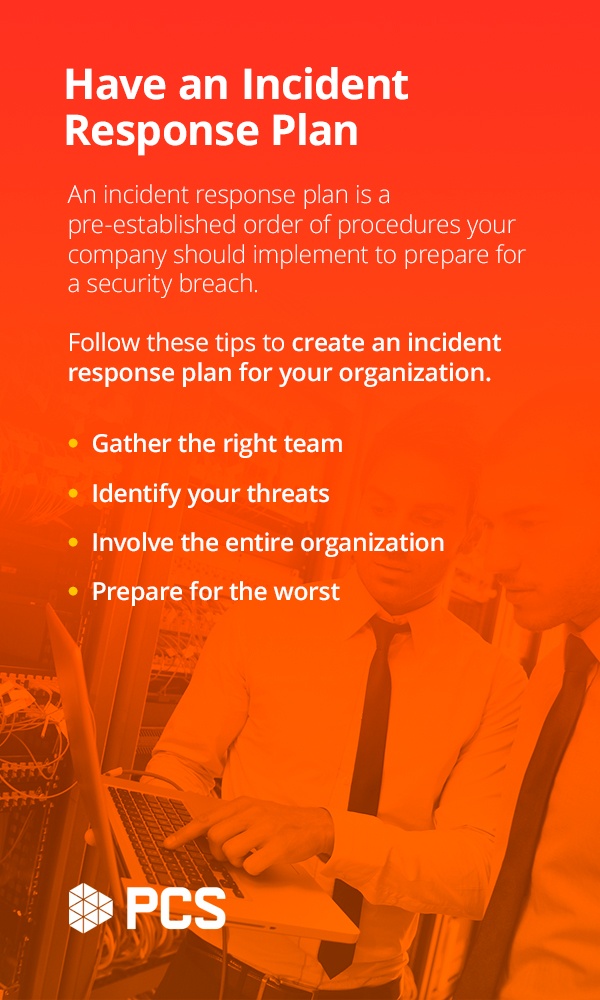Can your business afford a $9.44 million security breach? Unfortunately, that was the average cost of a data breach in the United States in 2022. In addition to steep financial losses, companies risk tarnishing their reputations, losing valuable investor and customer loyalty and high legal fees if they’ve failed to maintain data compliance.
Learn more about the real costs of company security breaches and what you can do to minimize your risk for attack.

What Is the Average Cost of a Security Breach?
The average cost of a security breach depends on your industry, the nature of your business, the data you house, and the extent of the breach. Typically, data breaches per compromised record cost between $160-180.
Data breaches come in all shapes and sizes and aren’t always a result of ransomware or a malicious attack on your systems. They also occur when someone gains unwanted entry into a secure room, intercepts confidential information, or an employee neglects to follow all security procedures. They can happen when your system or business front is vulnerable like during extensive company changes, moves, natural disasters, or any system left unprotected by inadequate cybersecurity tools.
During a breach, companies lose money, and attackers may access private client and business information.
- Personally identifiable information: PII includes names, addresses, phone numbers, Social Security numbers, birthdates, legal ID numbers, and personal health details.
- Financial information: Attackers can learn private banking data about you, your employees, and your clients.
- Classified information: Classified information may include government documents, business contracts, and blueprints.
- Security codes: Some attacks may harvest passwords, entry codes, and other priceless information that hackers can use against you in even costlier ways.
Cybercriminals don’t only target large companies — small businesses are also at risk. The average cost of a data breach for small businesses in 2019 was $200,000. Considering more than half of all small businesses experience a data breach each year, and only 40% of small businesses operate at a profit, a cyberattack could mean the end of a dream.

What’s Behind the Average Total Cost of a Data Breach?
Data breaches are increasingly common and have long-lasting effects. When considering the total cost of a data breach, the first and most obvious loss is financial. Businesses of all sizes spend a fortune in legal fees, compliance fines, lawsuits, client reparations, and costs to repair damages and bolster security. But don’t discount the extensive loss that can also come to your company’s reputation and brand value. A ruined company image can be just as devastating as the financial ramifications.
Let’s break down what happens after a data breach to better understand the harmful aftereffects it can have on your company.
Fines and Legal Costs
Legal costs incurred might include attorney fees, regulatory fines and class-action lawsuits. All lawsuits and settlements — including those imposed by the state or the individuals affected — require an attorney, and you’re responsible for covering all legal fees and the ongoing cost of their time. Companies in some industries like financial and healthcare may also face regulatory fines if you fail to meet compliance standards to protect the consumer or patient data.
Some states have laws requiring companies to notify consumers affected by a data breach, and failure to do so could result in further action. Depending on the state and specific case, you may face penalties for each breached record or the incident as a whole.
Though all organizations risk costly legal fees and fines, some of the most expensive breaches occur in these industries:
- Health care
- Financial
- Government
- Education
- Business
- Energy
- Pharmaceuticals
- Technology
- Industrial
- Services
- Entertainment
- Transportation
- Retail
Fines are another significant cost for data breaches, regardless of industry. After the 2017 Equifax data breach, the credit reporting company agreed to pay at least $575 million, on top of the cost of fixing the framework issue that left user information vulnerable. A judge ordered them to pay an additional $7.75 million, $18.2 million and $19.5 million in 2020, on top of $2 million in legal fees.
Financial institutions aren’t the only ones paying out millions for breaches — a health system in Miami faced a $2.15 million fine for ongoing HIPAA violations.
Reputation Damage
Perhaps just as costly as legal fees and fines is the damage a data breach can inflict on your company’s reputation. Business reputation is so paramount that 90% of customers refuse to do business with a company if it has a negative reputation or bad reviews. Since more than half of consumers research businesses before contacting them or making a purchase, your organization needs to do everything in your power to protect your public image and let potential customers know their information is safe.
A damaged reputation can also interfere with possible partnerships and expansion opportunities. If your business relies on investor support or hopes to in the future, a significant data breach or injured reputation could set off a negative chain of events.
Lost Brand Value
Customer loyalty is a critical part of building brand value. It’s more cost-efficient to retain existing customers than to attract new ones, and return customers can be your brand’s most significant asset.
When a customer is loyal to your brand or company, they are more likely to:
- Recommend your business, service or product to others.
- Leave a positive review on a public forum.
- Do business with you again.
- Give you valuable insight into how to improve your business or product.
- Attend and advertise events and promotions.
- Try new products or services when released.
Building a strong brand with loyal customers takes diligence and care, especially concerning their personal information. A data breach exposing financial information or PII can cause even your most loyal clients to take their business elsewhere.
How to Reduce the Cost of a Data Breach
Though the costs and fallout of a security breach are undoubtedly steep, there are ways to reduce your business’ losses and minimize the likelihood of experiencing a cyberattack in the first place. By taking a few preventive steps and investing in the right equipment, you can set your business and team up for lasting success against potentially devastating data breaches.

Have an Incident Response Plan
An incident response plan is a pre-established order of procedures your company should implement to prepare for a security breach. Company leaders can give employees and departments specific escalation instructions when they detect a threat, and the members of your incident response team can quickly isolate and deal with the issue before it can grow any larger.
Follow these tips to create an incident response plan for your organization.
- Gather the right team: Your incident response team should include security experts with experience in detecting, managing and correcting cybersecurity concerns. Invest in quality training for your existing IT professionals, outsource to a third party or hire additional employees if necessary.
- Identify your threats: Consider your most significant data threats and create a specific plan that deals with them before moving on to less likely scenarios. For example, health care institutions may want to focus on strengthening their response to HIPAA violations, while a retail store might be more concerned with encrypting online payment methods.
- Involve the entire organization: Efficient cybersecurity involves everyone’s cooperation, from entry-level professionals to top-level management. Your incident response plan should be specific, so everyone knows their role in protecting your organization’s data and the steps they need to take during an incident. You should also incorporate regular feedback from all members of your organization and use it to inform ongoing training and plan adjustments.
- Prepare for the worst: Some problems are too extensive or unexpected for even the most organized incident response teams. That’s why you also need a disaster response plan, so your company can bounce back quickly if ransomware or a similar threat leaves your data inaccessible.
Invest in the Right Technology
Investing in cybersecurity technology could mean the difference between a security threat and a security breach. A few common examples include cloud technology and security software.
Cloud technology is a virtual storage method that can protect your data from on-site threats, like natural disasters and access control, enhanced by things like virtual firewalls for extra protection. You can also use the cloud to automatically back up your data instead of storage hardware or portable media, which are more susceptible to damage or compromise.
Security software, including anti-virus and anti-spyware, should be active and up to date. Check for patch releases and do not allow your license to expire before annual renewal.
Get a Security Audit
A third-party IT expert or cybersecurity organization can conduct a security audit on your business and its existing security systems to identify weaknesses and help you take steps to fix them. These audits give professionals a chance to analyze your potential threats and pinpoint which parts of your business could be most vulnerable in the event of a cyberattack. They can help you prioritize your incident response plan and tailor your response to fit each unique scenario.
Security auditors are also more aware of industry trends and emerging cybersecurity threats. They have access to the latest technology and insights to optimize your cybersecurity and strengthen your organization’s defenses. How often you participate in a security audit depends on your goals. Some organizations rely on an audit to ramp up cybersecurity efforts, while others enjoy the peace of mind that comes with annual checkups.
Enroll in a Data Breach Insurance Plan
Data breach insurance can protect your organization’s finances and help you recover more quickly if you experience a data attack. You can purchase insurance plans that explicitly cover data breaches or enroll in a more comprehensive coverage plan that addresses multiple cybersecurity threats, sometimes called a cyber-liability policy. Paying into an insurance plan can be far less costly than the total data breach cost your company may face.
Depending on the policy, your cybersecurity insurance plan could include coverage for:
- Lost revenue
- Legal fees
- Compliance fines
- Hardware and software damage
- Investigation costs
- Data restoration
- Ransomware extortion payments
- Customer notification costs
- Public relations assistance
- Regulatory penalties
- Some post-disaster assistance
Since every organization’s cyber-needs and budget are different, you should research all your options before investing in an insurance plan.
How Much Does Cybersecurity Cost?
Now that you know more about the threat of data breaches, how much a breach costs, and how you can protect yourself against them, you’re probably wondering about protection costs. After all, if the goal is to spare your company from expensive losses, you don’t want your cybersecurity plan to be equally costly.
Fortunately, technology has made cybersecurity options more accessible and customizable than ever before, so you can find the right combination of software and equipment to fit your needs and budget. Every investment you make into your company’s cybersecurity pays for itself quickly by offering peace of mind and protection against even costlier attacks.
There are also many cost-efficient and even free methods of strengthening your company’s existing cybersecurity plan.
- Training your employees: Engage in regular employee training to instruct your staff on recognizing cyber-threats and signs of a potential breach. Have a thorough escalation plan in place, so concerns reach the right person or department quickly enough to isolate the issue. Employee training should also include tips for password selection and guidelines for device security or building access where applicable.
- Clearing or tossing unused devices: When recycling old devices or giving new employees a pre-used company phone, computer or tablet, be sure to manually reset and wipe all information and data beforehand. When devices are too outdated to work, or your company outgrows the need for them, recycle them at an e-waste center instead of leaving them around the office where they are vulnerable to unwanted access.
- Conducting thorough security checks: Conduct thorough background checks and always confirm references with every new hire, third-party contractor or other partnership that has access to any of your company’s secure information, passcodes or data.
Reduce Your Company’s Risk With Help From PCS
Do worries about your company’s cybersecurity keep you up at night? We get it. Security breaches can have costly, lasting effects on companies of all types and sizes. That’s why we strive to be the most helpful IT company in the world — because your business and peace of mind depend on us.
Our IT services include:
- Data backup and protection
- Helpdesk support
- Computer tech support
- Mobile device management
- IT, server, and network management
We help clients across industries take control of their cybersecurity and get the assistance they need when they need it. We customize all support to fit your specific business and needs, with more than 200 experienced IT professionals on standby to guide you through the process. Contact our team to learn more and start implementing your hassle-free security today.

